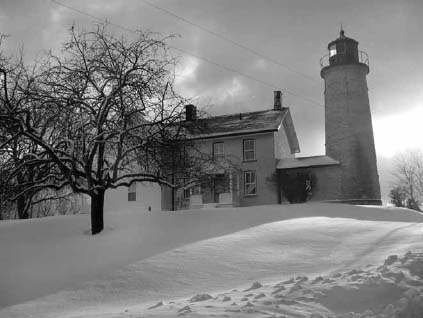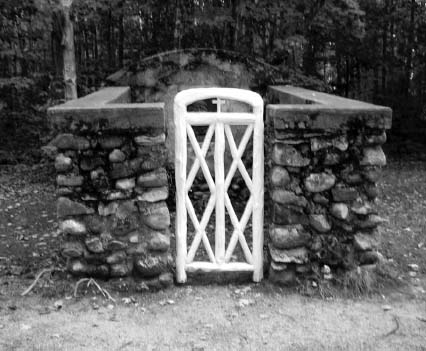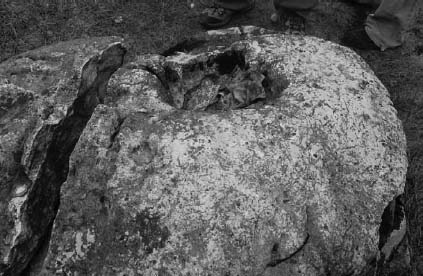
THE STRANGE TALES OF THE BEAVER ISLANDS
Beaver Island is a mysterious place with a lot of hidden history that is not common knowledge in every Michigander’s head. Ask any local what our state bird is, and he’ll say, “A robin!” Ask him about the Mormon King of Beaver Island, and you might get a blank look and a shrug of the shoulders.
Beaver Island rests peacefully in Lake Michigan, twenty miles west of Charlevoix. Home to six hundred people year-round and plenty of tourists in the summer, its picturesque shores and acres of beautiful forest hold secrets that it won’t let go. Beaver Island is the largest of twelve sister islands. The first inhabitants of Beaver Island were the Odawas, also known as the Ottawas. Archaeological evidence shows early pottery from the Woodland period, and burial mounds in the harbor area were explored in 1871 by archaeologist Henry Gillman. The island was always a stopping point for people along the trade routes in the days of mass shipping on Lake Michigan. Irish immigrants were some of the first to settle on the island because of its excellent fishing, and it was nicknamed the “Americans’ emerald isle.” Unlike other islands in Lake Michigan, Beaver Island has the most history and unique stories, creating the perfect elements for a few wandering specters.
Frederick Stonehouse, a prolific Michigan maritime author, points out that he feels that Beaver Island has the “greatest potential for haunting activity. No other area has the history of conflict, trauma and the interplay of people as the Beaver Island area.” Stonehouse feels that there have probably been a lot of stories about ghosts and paranormal phenomena on the island, but much of it has gone unreported due to the small population and its remoteness.
History and hauntings are partners in the paranormal. Where there have been traumatic and exciting events, there is usually a haunting or two that goes with it. One could look at it as an island of untouched paranormal potential.
STRANGE, STRANGE STRANG
James Jesse Strang is one of Michigan’s lesser-known and more fascinating characters in history. For starters, he was the only man in the United States to ever declare himself a king and to establish a kingdom. Strang was an interesting individual who early on in life had dreams of becoming royalty. According to his diary, he even wanted to find a way to marry into the royal family of England. An intelligent man, Strang held a law degree, had a seat in the Michigan legislature and was a newspaper editor, a Baptist minister and a postmaster, among other miscellaneous jobs that made up his eclectic resume. But everything in James’s life changed in 1844, when he met the charismatic leader of the Mormons, Joseph Smith.
Within just a few short months, James was baptized and appointed an elder within the Mormon Church. Strang and Smith hit if off immediately, but when Joseph Smith was assassinated later that same year, a fight for the succession of leadership quickly ensued between James Strang and Brigham Young. Strang argued that he had a letter proving that Joseph Smith had appointed him successor of the church in the event of his death, but Brigham Young, being the more popular of the two, won the argument and was appointed head of the church. Strang, believing that he was the rightful heir and guided by a vision, grabbed what followers he could to start his “heaven on Earth” on Beaver Island in 1848. Eventually, more than two thousand Mormons were living on the island.
Perhaps it started with good intentions, but the final chapter of the Mormon occupation of Beaver Island didn’t end well. In the beginning, Strang condemned the practice of polygamy, but as time went on, Strang took on a secret second wife, Elvira Eliza Field. She traveled beside him dressed as a man and was introduced to people as Charles J. Douglas, Strang’s “nephew” and secretary. He eventually encouraged his followers to take on at least a second wife. Strang took on five wives total and fathered fourteen kids by them. At one point, every wife, excluding his first, was pregnant by him.
Strang became more tyrannical and despotic as time went on, and followers soon became haters. Thomas Bedford and another man, Alexander Wentworth, planned the assassination of Strang and succeeded in their mission on June 16, 1856. James died from his wounds on July 9. The two men were never charged with murder; it was believed that the U.S. government had something to do with it. After the assassination, Bedford and Wentworth escaped on the U.S. Navy gunboat Michigan, which was docked at Beaver Island. Followers of Strang still exist today, although their numbers are very small.
Following King Strang’s death, the Mormons were chased off the island. Strang had reigned for eight years. After his death, many of the original people who fled the island because of the Mormons came back, along with a large migration of Irish people. They found an improved island, with new buildings and a town that was called St. James. The Kings Highway, built by the Mormons on Beaver Island, is still used today.
Is James Strang still king of his island in spirit form? The Old Mormon Print Shop, built in 1850, is the only building left standing from the time of the Mormon occupation. It is now the museum for the Beaver Island Historical Society.
Strang was shot on the shore in front of the shop, and some people claim to have seen his spirit in the area. Given the extreme event of Strang’s assassination, it is possible that the area has a residual haunting. Two ghostly men have been spotted in the bushes where Strang was assassinated on multiple occasions. People who have visited the Old Print Shop have felt strange on the second floor, but there is no real evidence of a haunting in the museum.
BEAVER ISLAND LIGHT AND ITS GHOST…OR LACK THEREOF
Beaver Island Light (also known as Beaver Head) is built on a bluff on the southern end of the island. The first light was built here in 1852, but after several years, the tower collapsed. There doesn’t seem to be much information on that particular light. In 1858, the current light was built. The lightkeeper’s dwelling was attached to the tower in 1866. The light was discontinued in 1962, and like most of the lights that were taken out of service, it quickly went into disrepair. Weathering and vandalism were destroying the buildings, and the property was considered a lost cause until the Charlevoix Public School District was deeded the land in 1975. Restoration through the years has made this old place beautiful again, and it is now the home of the Beaver Island Lighthouse School. The school helps troubled students graduate from high school. The lighthouse tower is open to the public, so anyone can retrace the steps of the lightkeeper as he traveled up the cast-iron stairs daily to maintain the light. The light is on the National Register of Historic Places and can boast being one of the oldest lighthouses on the Great Lakes.

The Beaver Island Light. Photo by Kristin Speer.
Is there a ghost in the Beaver Head Light Station? Stories have circulated about a ghost being in the light. Phantom footsteps and other strange disturbances have been heard on the tower stairs and on the second floor, but nothing major. Students at the Beaver Lighthouse School have talked about a ghost, but kids will talk, and when it comes to spooky stuff, they will talk even more! A former teacher at the Beaver Island Lighthouse School said that the students spent a night in the light one night and couldn’t even make it through the entire night. They were too spooked! For now, it seems, this is just ghostly speculation, but what would a lighthouse be without its ghost?
THE ENIGMATIC PROTAR
If you have ever just wanted to get away from it all, Beaver Island is the place for you and for a mysterious man by the name of Feodor Protar, who lived on the island from 1893 until his death in 1925. During his time on the island, Protar’s status among his fellow islanders was near saint like, and he gained the recognition and respect of anyone who met him. If said in two syllables with a robot-like voice, the name “Pro-Tar” sounds like it’s from another planet, but it would seem that Protar was, in fact, a “heaven-sent friend,” as the inscription on his tombstone implies. He was known as “Dr. Protar” to the islanders, and he spent his final years helping his fellow islanders with simple remedies and folk cures when they weren’t feeling well. Old photos of Protar show him sporting a bushy, Santa-like beard and long white hair—a cross between Santa Claus and Walt Whitman, two people who shared similar characteristics with Protar.
Traveling the Great Lakes, Protar was introduced to Beaver Island after a storm forced him to dock his boat there. Something about the island resonated with him, and he started to vacation there regularly. On one of his trips, he found an old, empty log cabin, inquired about it and became owner of two hundred acres of land and the cabin. Like a hippie ahead of his time, Protar lived off the land, let his hair and beard grow long and even kept a diary of daily weather on the island. He was a mystery when he arrived and stayed a mystery for the rest of his life. No one questioned his origins or bothered him. He even went as far as to hide his real last name. “Protar” was an anagram for his real last name: Parrot. His neighbors knew he preferred to keep to himself. He was essentially a hermit from the moment he set foot on the island. But Protar was kind and always there to help anyone in need of his assistance or advice, especially poor people who couldn’t afford the doctor in the island’s town of St. James.
Protar’s biographer, Anje Price, spent a considerable amount of time researching who the real Protar was. Born in Russia around 1838, Protar came from an educated family of doctors and scientists. Protar had also studied medicine for a time, hence the reason he was able to give simple medical advice. Legends and stories circulated while he was still alive. Some people have speculated in the past that Protar was running from the Russian government and was in some type of exile due to his mysterious nature, but Price feels that he was running from the “man within.” He was looking for a simple and spiritual life. One of his strongest beliefs was the old saying, “Better to give than to receive.” Price wrote that Protar was “a haunted, hunted, desperate man,” and he seemed to be his own worst critic.

Protar’s tomb on Beaver Island. Photo by Kristin Speer.
On the night before his death, a passage in one of his books was marked; it read, “The only preparation for death is a virtuous life.” Had Protar sensed the end coming? Ironically, one of Protar’s closest friends (who no doubt knew the secrets behind the man), Dr. Carl Bernhardi, died on the very same day as Protar, both men taking their secrets to the grave. It was Protar’s wish to be buried at sea, but laws prevented that from happening. The island people built a tomb and monument for him, inscribing it, “to our heaven-sent friend…who never failed us. In imperishable gratitude and admiration, his people of Beaver Island.” Feodor Protar was so highly respected that some speculate they buried him at sea anyway and put up the monument so that no one suspected they had broken the law. To this day, Protar’s spirit is felt on the island that he so loved. He is now part of the land and the spiritual world with which he was trying to become one. Protar’s old cabin can be visited and is on the National Register of Historic Places.
THE MYSTERIOUS STONE CIRCLE OF BEAVER ISLAND
Beaver Island is home to a mysterious set of stones. There are thirty-nine stones in total, creating a 397-foot circle. The stones vary in size, and how the stones got there is the biggest mystery of all. Most assume that it was done by the Native Americans. The stones were found in 1985 by Terry Bussey, who was looking for Native American artifacts and found something she wasn’t planning on discovering. When she came upon the scattered stones, something told her that they weren’t placed there by nature. There seemed to be a pattern, and some stones appeared to have been hand carved. Bussey used a compass, spent a couple nights under the stars with the stones and noticed that the stones connect to star positions. Later research found that the stones were aligned to the midsummer solstice.

The largest stone in the Beaver Island Stone Circle. Offerings are now placed in the center of it. Photo by Kristin Speer.
Some archaeologists shrug off the stones as nothing, while others speculate that they were placed by the Mound Builders thousands of years ago or the more recent Native Americans who inhabited the island for so long.
There are smaller groups of circles that have been added to for spiritual purposes, and the pattern of the stones is similar to that of a Native American medicine wheel. The thing that perplexes archaeologists about the stones is the fact that the bands of Native Americans living in that area didn’t usually create stone monuments. So who placed the stones, and what were they for? There is a lot to be learned about Michigan’s ancient history.
HIDDEN TREASURE OF THE MORMON KINGDOM
There is a story told about hidden treasure that was buried on High Island when the Mormons were being kicked off the island after Strang was killed. As treasurer and “king” of the island, Strang took it upon himself to be the sole keeper of the kingdom’s wealth. It was expected of the followers to give a tithe, as Mormons still do today. On the day that Strang was shot, one of his loyal followers went to retrieve the money hidden away and carried it to a cabin west of town in St. James. Under the light of the moon, the box was quietly taken away on a boat and rowed over to nearby High Island. The man ran to a spot not far from the shore and buried the box safely in the ground.
Since that time, the island has been stripped of its trees for lumber, and it is not known whether the treasure was found or even if it had ever really been buried on High Island. The box of cash could still be buried somewhere out there, but odds are that the secret is long sealed away with dead lips.
High Island was also home to the House of David sect, from Benton Harbor, which arrived in 1912 after its leader, Benjamin Purnell, purchased the High Island lumber company. These memorable people were best known for the men’s long hair, which they never cut, their excellent traveling baseball team and their belief that they would live for one thousand years. Benjamin Purnell also went by the title “king.” The House of David eventually fell apart after the government came after Purnell on morality charges. The members living on High Island were gone by the 1940s, and no traces of their existence remain on the island, except, perhaps, the graves of their dead, which were never marked since they were supposed to live one thousand years.
When it comes to ghosts and colorful characters on Beaver Island, there is no doubt to many people who study Michigan maritime history that the islands have seen tons of fascinating history. In fact, Frederick Stonehouse points out in his work that “if there’s any place on Lake Michigan that has ghosts, Beaver Island has to have its share of them.”